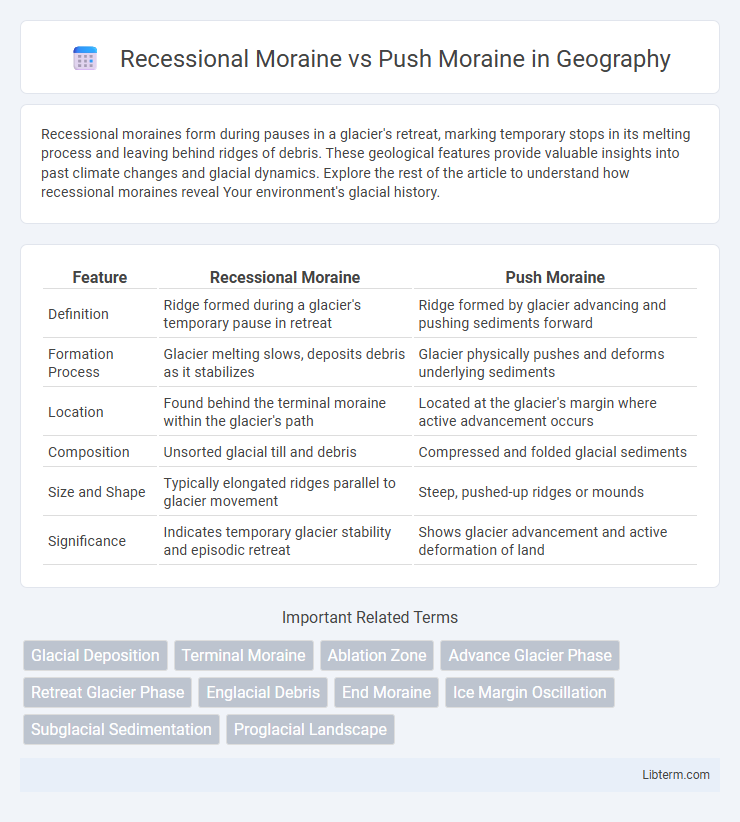Recessional moraines form during pauses in a glacier's retreat, marking temporary stops in its melting process and leaving behind ridges of debris. These geological features provide valuable insights into past climate changes and glacial dynamics. Explore the rest of the article to understand how recessional moraines reveal Your environment's glacial history.
Table of Comparison
| Feature | Recessional Moraine | Push Moraine |
|---|---|---|
| Definition | Ridge formed during a glacier's temporary pause in retreat | Ridge formed by glacier advancing and pushing sediments forward |
| Formation Process | Glacier melting slows, deposits debris as it stabilizes | Glacier physically pushes and deforms underlying sediments |
| Location | Found behind the terminal moraine within the glacier's path | Located at the glacier's margin where active advancement occurs |
| Composition | Unsorted glacial till and debris | Compressed and folded glacial sediments |
| Size and Shape | Typically elongated ridges parallel to glacier movement | Steep, pushed-up ridges or mounds |
| Significance | Indicates temporary glacier stability and episodic retreat | Shows glacier advancement and active deformation of land |
Introduction to Moraines
Moraines are accumulations of glacial debris formed by the movement and melting of glaciers. Recessional moraines develop as glaciers temporarily pause during retreat, marking previous positions of the ice margin, while push moraines form when advancing glaciers push and deform sediment into ridges. Understanding these moraine types provides key insights into past glacial dynamics and landscape evolution.
What is a Recessional Moraine?
A recessional moraine is a ridge of glacial debris deposited at a glacier's temporary stationary point during its retreat, marking pauses in the melting process. Unlike a push moraine, which forms from the glacier actively pushing and deforming sediment forward, a recessional moraine accumulates from sediment dropped as the glacier stabilizes. These moraines provide important insights into the historical dynamics and fluctuations of glacier movements.
What is a Push Moraine?
A push moraine forms when a glacier advances and pushes unconsolidated debris, such as soil and rocks, into a ridge at its front. Unlike recessional moraines, which mark pauses during glacier retreat, push moraines indicate active glacial movement and deformation of sediment. These moraines provide critical evidence for understanding glacier dynamics, ice advance rates, and paleoclimate conditions.
Formation Processes: Recessional vs Push Moraines
Recessional moraines form during temporary halts in glacier retreat, where debris accumulates at the glacier's snout as it pauses, creating ridges parallel to the glacier's flow. Push moraines develop when advancing glaciers physically push and deform previously deposited sediments, resulting in compressed and elevated ridges. The key difference lies in formation processes: recessional moraines mark stationary glacier positions during melting phases, while push moraines result from active glacier advance and sediment displacement.
Key Differences Between Recessional and Push Moraines
Recessional moraines form as glaciers temporarily pause during retreat, creating ridges of debris that mark stability points, while push moraines result from active glacial advancement pushing and deforming previously deposited sediments. Recessional moraines typically have a more layered and sorted sediment structure, reflecting gradual deposition, contrasting with the chaotic, compressed, and thrust sediment layers found in push moraines. The spatial distribution of recessional moraines is often multiple and parallel to the ice margin, whereas push moraines are usually singular, marking a concentrated zone of ice advance.
Geological Features and Characteristics
Recessional moraines form as ridges of debris deposited during pauses in a glacier's retreat, characterized by stratified till and sorted materials that reflect temporary stability. Push moraines result from the active advance of a glacier, pushing and deforming underlying sediment into chaotic, unsorted ridges with disrupted stratigraphy. The geological distinctions highlight recessional moraines as markers of glacial retreat phases, while push moraines indicate episodes of glacial re-advance and dynamic ice movement.
Environmental Significance of Each Moraine Type
Recessional moraines indicate pauses in glacial retreat, marking stages of ice stability and influencing sediment deposition patterns that shape diverse habitats. Push moraines form from glaciers advancing and bulldozing sediments, which can create ridges that alter drainage systems and affect local ecosystems. Both moraine types play critical roles in landscape evolution and soil development, contributing to biodiversity and watershed dynamics.
Notable Examples Around the World
Recessional moraines, such as those found in Glacier National Park, Montana, mark the former positions where glaciers temporarily stabilized during their retreat. Push moraines, exemplified by the extensive formations in the Netherlands, result from glaciers actively advancing and pushing soil and debris forward. Both types of moraines provide critical insights into past glacial dynamics and climate changes across regions like the Alps and the Canadian Shield.
Role in Reconstructing Glacial History
Recessional moraines mark former positions where glaciers paused during their retreat, providing crucial data points for reconstructing the timeline and rate of glacial melting. Push moraines form when advancing glaciers actively push and deform sediment, offering evidence of glacier dynamics and periods of advance. Both moraines serve as key geological indicators in mapping past glacial extents and understanding climate fluctuations during glacial cycles.
Summary and Importance of Differentiating Moraines
Recessional moraines form as a glacier temporarily pauses during its retreat, marking stages of glacier melting, while push moraines result from glacier advances that push and deform sediments. Differentiating between these moraines is essential for reconstructing past glacial dynamics and understanding climate history. Accurate identification aids in geological mapping, interpreting sedimentary records, and predicting future glacial behavior.
Recessional Moraine Infographic

 libterm.com
libterm.com